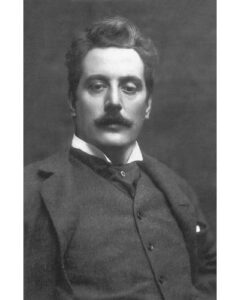
Verismo (Italian for “realism”) opera is a type of opera that emerged in Italy in the late 19th century, characterized by its realistic and gritty subject matter, and a focus on everyday people and their struggles. Verismo opera originated from an Italian literary movement of the same name.
Verismo opera sought to portray ordinary people and their emotions in a more direct and truthful way. Operatic verismo was marked by melodramatic, often violent plots with characters drawn from everyday life. Musical devices included passionate declamation by solo voices and emotionally charged harmonies and melodies.
In terms of subject matter, generally “[v]erismo operas focused not on gods, mythological figures, or kings and queens, but on the average contemporary man and woman and their problems, generally of a sexual, romantic, or violent nature.” However, three of the small handful of verismo operas still performed today take historical subjects: Puccini’s Tosca, Giordano’s Andrea Chénier and Cilea’s Adriana Lecouvreur. – Wikipedia
Verismo opera was influenced by a number of social, cultural, and artistic trends of the late 19th century. Key influences include:
- Realism in literature: Verismo opera emerged during a time when the literary movement of realism was gaining popularity. Realism emphasized the depiction of everyday life and experiences, often portraying the struggles of ordinary people.
- Social and economic changes: The late 19th century was a period of rapid social and economic change in Italy. Industrialization and urbanization brought new challenges and opportunities, and Verismo opera reflected the struggles of ordinary people in this changing society.
- Political upheaval: Italy was also going through a period of political turmoil during the late 19th century, with the unification of the country and the rise of political movements such as socialism and anarchism. Verismo opera often dealt with political themes and criticized the social and political systems of the time.
- The influence of French naturalism: Verismo opera was also influenced by the French literary movement of naturalism, which emphasized the scientific observation of human behavior and the portrayal of social realities.
- Musical trends: Verismo opera was part of a larger trend in opera towards greater realism and naturalism, with composers seeking to create more believable characters and situations. Verismo opera also drew on the traditions of Italian opera, including the use of recitative, aria, and ensemble singing.
Here are a few Verismo operas available on IPA Source:
- La bohème
Listen to Anna Netrebko
- I pagliacci
Listen to Britone Apollo Granforte and Soprano Hina Spani
- Cavalleria Rusticana
Listen to Mario del Monaco
- Tosca
Listen to Gabriel Bacquier
- La fanciulla del West
Listen to Giangiacomo Guelfi
- Adriana Lecouvreur
Listen to Franco Corelli
- Fedora
Listen to Igor Golovatenko
[Image Giacomo Puccini in a studio photograph is from an unknown source and in the public domain, via Wikimedia Commons – https://commons.wikimedia.org/wiki/File:GiacomoPuccini.jpg]
